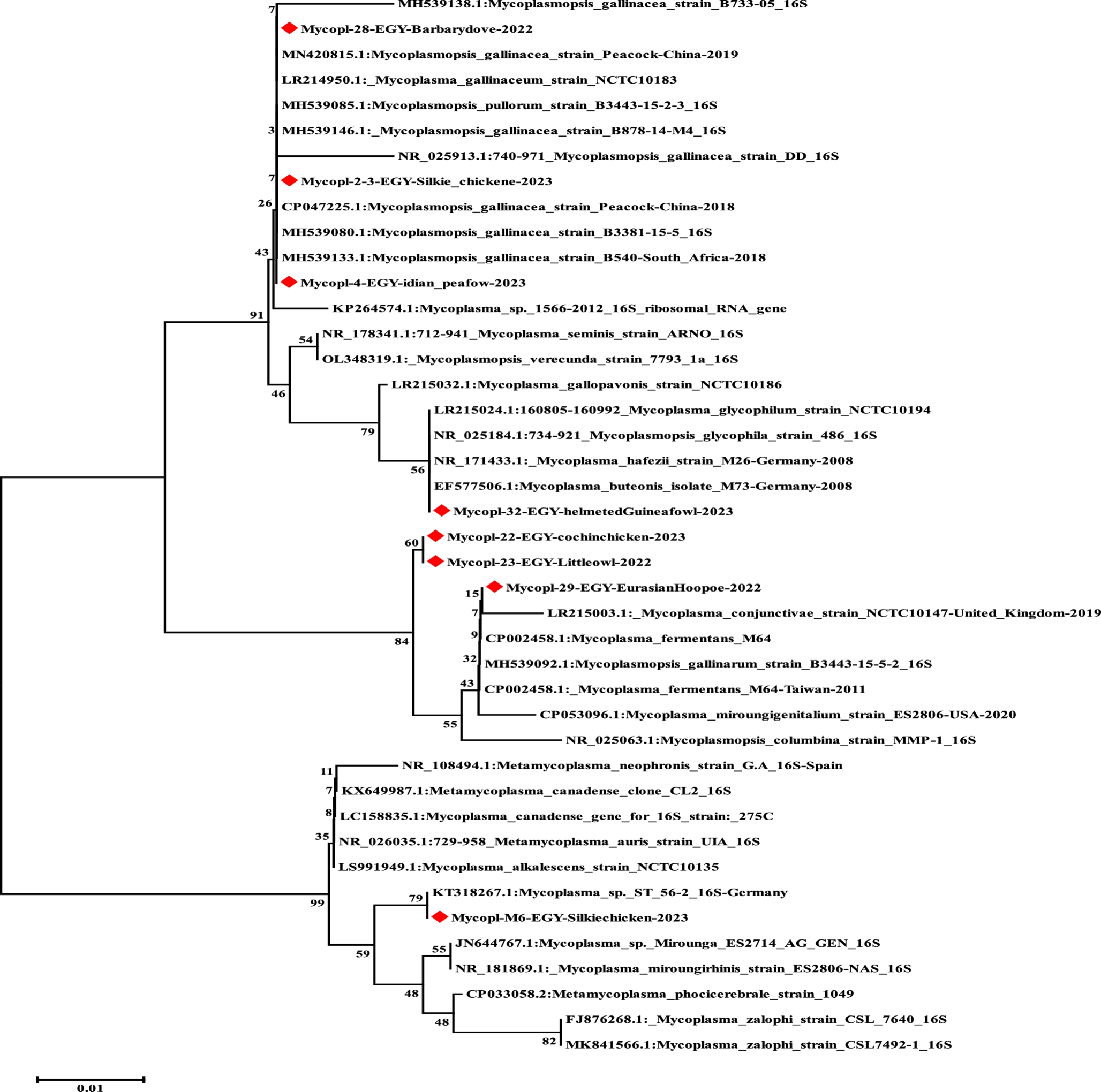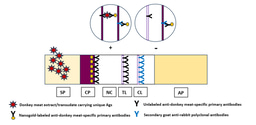A glimpse on Mycoplasma species circulating in wild and captive bird communities in Egypt: prevalence and phylogenetic analyses
Published in Microbiology and Zoology & Veterinary Science
The public health interest in birds as pathogen vectors and their role in disease epidemiology has increased due to new infections in wildlife and their possible zoonotic hazard. Mycoplasmas are the smallest self-replicating organisms found widely in nature. There are more than 100 species in the genus Mycoplasma; most of them are commensals or opportunistic pathogens, although some seem more pathogenic than others, relevant to the severity of the associated disease, and hence their effect on production and their economic consequences, as well as the frequency of occurrence worldwide. Mycoplasma spp. cause various clinical symptoms, including pulmonary, reproductive, conjunctivitis, arthritis, and skeletal problems. Mycoplasma spp. can cause detrimental diseases in chickens and result in significant financial losses for the global poultry industry. Mycoplasma spp. are considered non-pathogenic or a component of the upper respiratory tract microbiota in other bird species, such as white storks, raptors, and several kinds of waterfowl. These species of birds frequently exhibit these microbes in healthy individuals.
Some wild bird species may have respiratory pathogens such as M. gallisepticum in house finches, even though healthy individuals of these species do not have these organisms. M. gallisepticum and M. synoviae, two well-known poultry mycoplasmas that are thought to be the most pathogenic, have also been found in various wild bird species and represent different orders. Since many mycoplasmas are host-specific, infections caused by M. gallisepticum and M. synoviae primarily cause clinical signs in the wild species of Galliformes. The house finch (Haemorhous mexicanus) population in the USA experienced epidemic conjunctivitis in 1994 because of M. gallisepticum, which had a high fatality rate and a high prevalence. Up to 60% of the house finch population perished before the illness stabilized at a low prevalence level.
Wild waterfowl are considered carriers and reservoirs of numerous bacteria and viruses that can cause different diseases. A single pathogen can typically infect a wide variety of bird species belonging to many orders. Nonetheless, it is well-recognized that Mycoplasma spp. are host-specific microbes. Bird hosts are typically Mycoplasma spp. vectors; however, the infection does not cause illness symptoms in them. The transmission of mycoplasmosis between domestic and wild birds in the same order has been documented in many previous reports. Only wild turkeys showed clinical indications of mycoplasmosis, such as respiratory problems and sinusitis, which was diagnosed as M. gallisepticum. Later, it was documented more frequently in game birds of the order Galliformes, including pheasants. Mycoplasma spp. were isolated from 82% of nestlings, 26% of juveniles, and 50% of adults in a study of injured or debilitated birds of prey in Germany. Using an immunobinding assay (IBA), these species were identified as M. gypis, M. meleagridis, M. falconis, and M. buteonis; five isolates were unidentifiable.
Mycoplasmas were found in birds from the Rio de Janeiro Zoo that did not exhibit any respiratory symptoms, and the frequency of M. synoviae was higher than that of M. gallisepticum. Among the orders examined, there were differences in Mycoplasma spp., M. gallisepticum, and M. synoviae, with the highest prevalence in prey-seeking birds, followed by Galliformes and Piciformes. Mycoplasma spp. found in Rio de Janeiro Zoo’s avian population attests to the agents’ circulation and the necessity of additional research on Mycoplasma spp. dissemination in zoos for Mycoplasma spp. epidemiological analysis. Molecular approaches have been utilized in conjunction with bacteriological isolation, as these bacteria are laborious, slow to grow exponentially, and require a richer culture medium. PCR does not require isolation from clinical specimens and is quick, sensitive, and inexpensive to run in the laboratory.
The objectives and the highlights of the current study are as follows: (I) To represent a pioneer contribution to wildlife, more specifically, wild birds, a study in Egypt was conducted, as there is very limited knowledge in this scientific field in Egypt. Also, there are a clear rareness in studies that have been performed on wild and captive birds in Egypt and our study represents one of the headmost studies to investigate the prevalence of Mycoplasma spp. in wild birds in Egypt; (II) to survey a wide variety of both wild and captive birds belonging to different orders, families, and species for the occurrence of Mycoplasma spp. from the wild birds’ focal areas in Egypt; (III) to elucidate the actual situation of the presence of M. gallisepticum and M. synoviae in wild and captive birds in Egypt as many mycoplasmas are known to be host-specific, infections brought on by M. gallisepticum and M. synoviae mostly elicit clinical symptoms in Galliformes wild species; and (IV) to analyze the genetic relatedness of selected Mycoplasma spp.—positive samples and to figure out their phylogeny to previously found strains from other parts of the world.
Beyond any doubt, the obtained results will be very important at both the national and international levels, as studies targeting neglected host species are always valuable for the development of public health strategies. This knowledge acts as a building block that equips the scientific community with a provisional view to be cautious of hidden threats that may be visible and disastrous one day through the carriers of zoonotic diseases, and/or host range spillover.
According to the results obtained, it is concluded that the estimated prevalence of Mycoplasma spp. in wild birds is different between wild and captive birds, and it depends on the method of detection and the species of bird. Also, the phylogenetic analysis revealed a high variability of Mycoplasma spp. and a high similarity to different isolates from different locations around the world, which sheds light on the role of migratory, wild, and captive birds in mycoplasmosis epidemiology. Also, the obtained results point fingers at wild and captive birds in Egypt, which could play a certain role in spreading diseases in the environment. After all, further studies are needed to establish the link between infections in domestic, wild, and captive birds. Due to the scarce contribution of the Egyptian scientific community in the field of wildlife and more specifically, the wild birds, the current contribution through the conducted study and the obtained findings could be considered a leading work in this field, which, by its role, fills a clear scientific gap and prospectively could be a cornerstone for further contributions in the same field.
Follow the Topic
-
Veterinary Research Communications

This journal publishes fully refereed research articles and topical reviews on all aspects of the veterinary sciences. Interdisciplinary articles are particularly encouraged, as are well argued reviews, even if they are somewhat controversial.






Please sign in or register for FREE
If you are a registered user on Research Communities by Springer Nature, please sign in